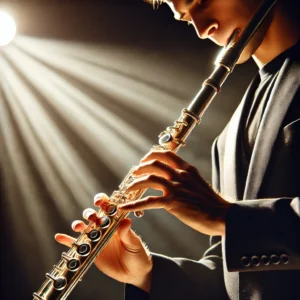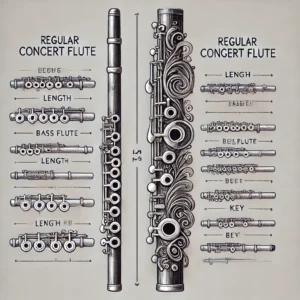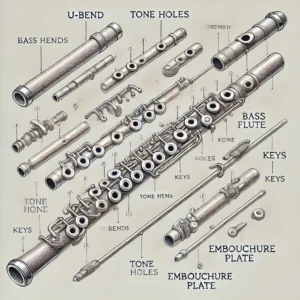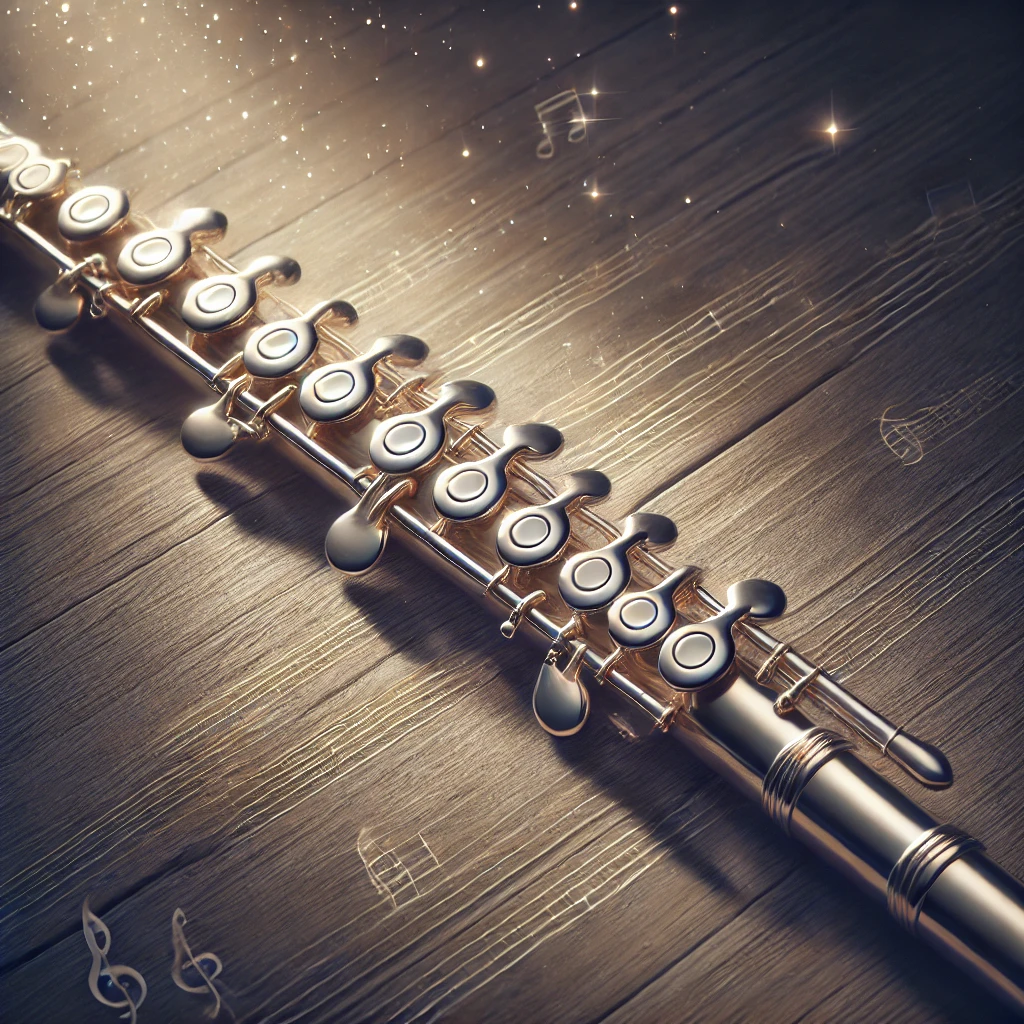The Magnificent World of Bass Flutes 🎵
The bass flute, a magnificent extension of the flute family, offers musicians an opportunity to explore deeper, richer tones that standard concert flutes simply cannot achieve. When I first encountered a bass flute during my conservatory days, I was immediately captivated by its distinctive sound and impressive presence. Furthermore, this versatile instrument has been gaining popularity among both professional musicians and enthusiastic amateurs in recent years. Additionally, the unique challenges and rewards of playing the bass flute make it a fascinating subject for both performers and music enthusiasts alike.
In this comprehensive guide, we’ll dive into everything you need to know about bass flutes. Moreover, we’ll explore their history, construction, playing techniques, and how to choose the right one for your musical journey. Subsequently, whether you’re a professional flutist looking to expand your range or a curious music lover, this article will provide valuable insights into the enchanting world of bass flutes.
What Is a Bass Flute? Understanding the Basics ⚡
The bass flute is essentially a larger version of the standard concert flute, typically pitched one octave below. Consequently, this gives it a rich, mellow tone that adds depth and warmth to musical compositions. Most notably, the bass flute features a curved headjoint that brings the embouchure hole within comfortable reach of the player.
Key Characteristics of Bass Flutes:
✅ Size: Approximately 146 cm (57 inches) in length
✅ Range: Typically from C3 to C6 (one octave below the concert flute)
✅ Weight: Generally between 1.5 to 2.5 pounds
✅ Material: Usually made from silver, silver-plated nickel, or gold
✅ Design: Features a curved headjoint for playability
The bass flute’s distinctive J-shape makes it immediately recognizable, with its curved headjoint designed to make this large instrument playable for musicians. Furthermore, the extra tubing length necessary to produce its deep tones results in a visually striking instrument that commands attention in any ensemble.

The Fascinating History of Bass Flutes 🕰️
The evolution of the bass flute reflects humanity’s ongoing quest to expand musical possibilities. While the standard flute has ancient origins, the bass flute as we know it today is a relatively modern development. However, historical records show that larger, lower-pitched flutes have existed in various cultures for centuries.
Historical Timeline:
- Ancient Roots: Large flutes have been used in various cultures throughout history, including ancient Chinese and Indian musical traditions.
- 17th-18th Centuries: Early experiments with bass register flutes appeared in European music, though these instruments were often difficult to play and lacked standardization.
- Late 19th Century: The modern bass flute began to take shape as flute makers experimented with ways to create playable instruments in the bass register.
- 20th Century Renaissance: The bass flute found its place in modern orchestras and chamber ensembles as manufacturers developed more refined designs.
- Contemporary Popularity: In recent decades, the bass flute has gained considerable popularity in contemporary classical music, film scores, and even some jazz compositions.
The bass flute’s journey throughout history illustrates the persistent innovation in musical instrument design. Moreover, as manufacturing techniques improved, so did the playability and accessibility of this magnificent instrument.
7 Amazing Facts About Bass Flutes You Need to Know 🌟
1. They’re Acoustic Powerhouses 💪
Despite their gentle, mellow tone, bass flutes can produce surprisingly powerful sounds in their lower register. Additionally, when played with proper technique, they can project well in ensemble settings. The resonant quality of bass flutes makes them particularly effective for creating atmospheric textures in contemporary music.
2. Bass Flutes Require More Air 💨
Playing the bass flute demands significantly more air than the standard concert flute. Therefore, players must develop specific breathing techniques to sustain notes effectively. As a result, experienced bass flutists often develop exceptional breath control that benefits their playing across all members of the flute family.
3. They’re Versatile Across Musical Genres 🎭
While often associated with classical music, bass flutes have found their way into diverse musical traditions:
- Classical ensembles: Adding depth to flute choirs and orchestras
- Jazz compositions: Providing unique textural elements
- Film scores: Creating atmospheric soundscapes
- World music: Blending with traditional instruments from various cultures
- Contemporary experimental music: Pushing the boundaries of sound production
4. The Curved Headjoint Is an Engineering Marvel 🔧
The iconic curved headjoint of the bass flute represents a brilliant solution to a fundamental design challenge. Without this curve, the instrument would be unplayable for most musicians due to its length. Furthermore, this design element maintains the acoustic properties while bringing the embouchure hole within reach.
5. Bass Flutes Can Be Made from Various Materials 🏭
Like other flutes, bass flutes can be crafted from different materials, each offering unique tonal qualities:
✅ Silver: Bright, projecting tone
✅ Gold: Warm, rich sound
✅ Wood: Organic, mellow quality (though rare in bass flutes)
✅ Silver-plated nickel: More affordable option with good tonal properties
✅ Carbon fiber: Lightweight modern alternative
6. They’re Important in Flute Choirs 👥
Bass flutes play a crucial role in flute choirs, serving as the foundation that anchors the ensemble’s sound. In addition, they create a bridge between the mid-range instruments and the even lower contrabass and subcontrabass flutes when present.
7. Playing Techniques Differ from Standard Flutes 🎯
Bass flute players must adapt their technique in several ways:
- Embouchure adjustments: A more relaxed embouchure helps produce the lower tones
- Finger spacing: The larger key system requires adjustments to hand positioning
- Air support: Stronger, more controlled airflow is essential
- Articulation: Modified tongue placement helps maintain clarity in the lower register
How to Choose the Perfect Bass Flute for Your Needs 🔍

Selecting the right bass flute requires careful consideration of several factors. Moreover, the significant investment these instruments represent makes thoughtful evaluation particularly important. Here’s what to consider when choosing your perfect bass flute:
Key Factors to Consider:
1. Professional vs. Student Models 🎓
Just like standard flutes, bass flutes come in different quality levels:
Student Models:
- More affordable entry point
- Simpler key system
- Often made with less expensive materials
- Good for determining if the bass flute is right for you
Professional Models:
- Jupiter DiMedici Bass Flute offers superior tonal quality and response
- More comprehensive key systems
- Crafted from premium materials
- Better intonation and playability
- Longer lifespan with proper care
2. Material Considerations 🧪
The material of your bass flute significantly impacts its sound character:
Silver:
- Bright, clear tone
- Good projection
- Pearl PFB-305 Bass Flute features a sterling silver headjoint that produces exceptional clarity
Silver-plated:
- More affordable than solid silver
- Still offers good tonal qualities
- The Gemeinhardt 2SPBF Bass Flute provides excellent value with its silver-plated body
Gold or gold-plated:
- Warmer, richer sound
- Higher price point
- Altus Bass Flute with 14K Gold Riser delivers unparalleled warmth in tone
3. Key System Options 🔑
Consider the key configuration that best suits your playing needs:
- C-foot vs. B-foot: Most bass flutes have a C-foot, but some professional models offer a B-foot for extended range
- Open hole vs. closed hole: While open hole models are less common in bass flutes, they’re available for players who prefer this configuration
- Split E mechanism: Improves response of the upper register E
- C# trill key: Facilitates certain trills and techniques
4. Weight and Ergonomics 🏋️♀️
Bass flutes are inherently heavier than concert flutes, making ergonomic considerations especially important:
- Support systems: Some models include floor supports or thumb rests
- Balance point: Check how the instrument balances when held
- Overall weight: The Di Zhao Bass Flute is known for its relatively lightweight design without sacrificing sound quality
Comparison of Popular Bass Flute Models
| Model | Price Range | Material | Key Features | Best For |
|---|---|---|---|---|
| Jupiter DiMedici Bass Flute | $8,000-$9,500 | Silver-plated | Curved and straight headjoints included, inline G | Professional performers |
| Pearl PFB-305 Bass Flute | $6,000-$7,000 | Silver headjoint, silver-plated body | Pinless mechanism, split E | Serious amateurs and professionals |
| Gemeinhardt 2SPBF Bass Flute | $4,500-$5,500 | Silver-plated | Offset G, C foot | College students and advancing players |
| Di Zhao Bass Flute | $5,000-$6,000 | Silver or silver-plated options | Lightweight design, excellent intonation | Players concerned about ergonomics |
| Trevor James Bass Flute | $3,500-$4,500 | Silver-plated | Modern key system, reliable mechanism | Ensemble players and educators |
Ready to elevate your musical experience? These high-quality bass flutes are available now with special pricing. Click through to see current offers and start your bass flute journey today!

Common Challenges When Playing the Bass Flute and How to Overcome Them 💢
Taking up the bass flute presents unique challenges even for experienced flutists. However, with dedicated practice and proper technique, these challenges can be overcome:
1. Air Management 💨
Challenge: Bass flutes require significantly more air than concert flutes.
Solution:
- Practice breathing exercises focusing on deep diaphragmatic breathing
- Work on developing efficient air use through long tone exercises
- Consider incorporating breathing techniques from yoga or meditation
- Use the Pneumo Pro Wind Director training tool to visualize and improve air direction
2. Hand Positioning and Comfort 👐
Challenge: The larger size and weight can cause hand and arm fatigue.
Solution:
- Invest in proper support systems like the Flute Flags Support Stand
- Take frequent breaks during practice sessions
- Develop strength in arms and hands through specific exercises
- Experiment with different holding positions to find optimal comfort
3. Intonation Issues 🎯
Challenge: Bass flutes can be challenging to play in tune, especially in the lowest register.
Solution:
- Regular practice with a tuner to develop awareness of pitch tendencies
- Learn the specific adjustments needed for problematic notes
- Use the Korg TM-60 Tuner and Metronome for precise intonation practice
- Focus on air speed and direction to improve pitch control
4. Articulation Clarity 👅
Challenge: Achieving clear articulation in the lower register can be difficult.
Solution:
- Practice articulation exercises specifically designed for bass flute
- Work on tongue placement and precision
- Start slowly and gradually increase speed
- Record yourself to assess and improve articulation clarity
Bass Flute Maintenance and Care Tips 🧰
Proper maintenance is essential for keeping your bass flute in optimal playing condition. Furthermore, due to their size and complexity, bass flutes require special attention to certain aspects of care.
Daily Maintenance Routine:
✅ Swabbing: Use a properly sized cleaning rod and cloth to remove moisture after each playing session
✅ Wiping: Clean fingerprints from the body using a soft, non-abrasive cloth
✅ Headjoint care: Pay special attention to cleaning the curved headjoint to prevent moisture buildup
✅ Key mechanism: Gently wipe the keys and mechanism to remove oils from fingers
Periodic Maintenance:
✅ Professional cleaning: Schedule annual professional cleanings
✅ Pad checks: Have pads inspected for wear and replaced as needed
✅ Mechanism adjustment: Ensure keys are moving properly and springs have appropriate tension
✅ Cork replacement: Replace headjoint cork when worn or compressed
Recommended Maintenance Products:
- Valentino Flute Care Kit includes specialized cleaning tools for bass flutes
- MusicNomad Premium Instrument Care System offers comprehensive cleaning solutions
- Runyon Flute Pad Saver helps extend the life of pads in humid environments
The Role of Bass Flutes in Different Musical Contexts 🎼

The versatility of the bass flute allows it to shine in various musical settings. Moreover, its unique voice has made it increasingly popular across diverse genres and ensembles.
Classical and Contemporary Ensembles:
In orchestral and chamber music, the bass flute adds depth and richness to the woodwind section. Additionally, contemporary composers have been exploring the unique timbral possibilities of the instrument, writing solo and ensemble pieces that feature its distinctive voice.
Notable works featuring bass flute include:
- Varèse’s “Density 21.5” (adapted for bass flute)
- Takemitsu’s “Voice”
- Harvey’s “Curve with Plateaux”
Flute Choirs and Ensembles:
The bass flute serves as the foundation in flute choirs, providing the essential bass line that supports the ensemble. Furthermore, specialized flute choirs with multiple bass flutes create uniquely textured soundscapes.
World Music Traditions:
Bass flutes have found their place in world music, where they often blend with traditional instruments to create innovative cross-cultural sounds. Additionally, their deep, meditative quality makes them particularly effective in certain traditional and ceremonial contexts.
Jazz and Experimental Music:
Innovative jazz musicians have incorporated the bass flute into their compositions and improvisations. Moreover, the instrument’s capacity for extended techniques makes it particularly suitable for experimental music approaches.
Essential Accessories for Bass Flute Players 🎒
To enhance your bass flute playing experience, consider these essential accessories:
Support Systems:
- Flute Flags Bo Pep Support Stand provides reliable support for extended playing sessions
- Thumbport Thumbrest helps with proper hand positioning and reduces strain
- Hercules Flute Stand offers safe storage during breaks and display
Cleaning and Maintenance:
- BG Microfiber Cleaning Cloth Set includes specialized cloths for different parts of the instrument
- Signature Flute Bass Flute Swab designed specifically for the bass flute’s dimensions
- Ferree’s Tools Flute Pad Saver helps extend pad life by absorbing moisture
Performance Enhancers:
- Yamaha Silent Brass System for Flute allows for quiet practice with headphones
- Faxx Flute Lip Plate Patch improves comfort during long playing sessions
- Focusrite Scarlett Solo Audio Interface for high-quality recording of your bass flute performances
Learning Resources for Bass Flute Players 📚
For those looking to develop their bass flute skills, these resources provide valuable guidance:
Instructional Books:
- “The Bass Flute Method” by Peter Sheridan offers comprehensive instruction specifically for bass flute
- “Low Flutes: A Practical Guide” by Chris Potter covers techniques for bass and other low flutes
- “The Extended Techniques for Flute” by Robert Dick includes sections on bass flute techniques
Online Resources:
- The Flute Society of America provides resources specifically for low flutes
- Jennifer Cluff’s Flute Focus includes articles about bass flute playing
- The International Low Flutes Festival offers masterclasses and workshops
Videos and Tutorials:
- Flutetunes.com features specialized bass flute repertoire
- YouTube channels by professional bass flutists provide valuable visual instruction
- Masterclass recordings from flute conventions and festivals
Frequently Asked Questions About Bass Flutes ❓

How much does a good bass flute cost?
Bass flutes range significantly in price, from entry-level models starting around $3,000 to professional instruments that can exceed $10,000. The Trevor James Bass Flute offers excellent value for advancing players, while the Jupiter DiMedici Bass Flute represents the professional end of the spectrum.
Can I play bass flute if I already play concert flute?
Yes! Most bass flute players begin on the concert flute. The fundamental techniques are similar, though you’ll need to adapt to the larger size, different ergonomics, and increased air requirements. Your existing flute skills will transfer, but expect a period of adjustment.
How heavy is a bass flute?
Bass flutes typically weigh between 1.5 to 2.5 pounds (approximately 700-1100 grams), which is significantly heavier than a standard concert flute. This makes support systems particularly important for comfortable playing.
Are there left-handed bass flutes?
While standard flutes are designed for right-handed playing, some manufacturers can create custom left-handed models. However, these are specialty items and usually come with a significant price premium.
Can children play the bass flute?
Due to its size, weight, and air requirements, the bass flute is generally not suitable for young children. However, teenagers with well-developed lung capacity and sufficient physical size may begin to explore the bass flute, especially if they already have experience with the concert flute.
How does the fingering compare to a regular flute?
The fingering system on a bass flute is essentially identical to that of a concert flute. However, the larger key size and spacing may require some adjustment to hand positioning and finger movement.
What music is best for beginning bass flutists?
Beginners should start with simple melodies in the middle register before exploring the extremes of the instrument’s range. Collections like “First Repertoire for Bass Flute” by Trevor Wye provide appropriate material for developing players.
Conclusion: Embracing the Magnificent World of Bass Flutes 🎵
The bass flute represents a magnificent expansion of the flutist’s sonic palette, offering rich, resonant tones that can transform musical experiences. Throughout this article, we’ve explored the unique characteristics, challenges, and joys of this remarkable instrument. Furthermore, we’ve examined how to choose, maintain, and play the bass flute across various musical contexts.
Whether you’re a professional musician looking to expand your instrumental arsenal or an enthusiastic amateur drawn to the bass flute’s distinctive voice, the journey into bass flute playing offers rewarding musical possibilities. Additionally, as manufacturing techniques continue to improve, these instruments are becoming increasingly accessible to a wider range of players.
I encourage you to explore the enchanting world of bass flutes, whether through listening to recordings, attending performances, or taking the leap to play one yourself. Moreover, the unique perspective that comes from engaging with this magnificent instrument can transform your entire approach to music-making.
Ready to begin your bass flute journey? The models we’ve discussed represent the finest options available today. Click through to discover current pricing and availability – your musical adventure awaits!
More FQAs:
❓ What is a bass flute?
✅ A bass flute is a member of the flute family pitched one octave below the standard concert flute, producing a rich, mellow tone...
❓ How does the bass flute differ from the standard concert flute?
✅ The bass flute is larger, with tubing approximately 146 cm long, and features a J-shaped headjoint to accommodate its size, resulting in a deeper sound...
❓ What is the range of the bass flute?
✅ The bass flute's range extends from C₃ (one octave below middle C) to C₆, allowing for a versatile lower register...
❓ In what musical settings is the bass flute commonly used?
✅ The bass flute is often featured in solo performances, chamber music, and flute choirs, adding depth with its unique timbre...
❓ Who invented the modern bass flute?
✅ The modern bass flute design was developed in the 1930s by British manufacturers Rudall and Rose, incorporating the Boehm key system for improved playability...
Recommended for You:
- 10 Best American Bass 12 Subwoofers That Will Transform Your Audio Experience in 2025
- Jazzmaster Bass: 7 Incredible Reasons Musicians Choose This Powerhouse Instrument
- Flatwound Bass Strings: 7 Amazing Benefits for Smooth Playing & Warm Tone
Disclaimer: This article contains affiliate links. If you purchase products through these links, we may earn a small commission at no additional cost to you.


